How to grow goji berries – expert advice for cultivating succulent wolfberries
Once you know how to grow goji berries, you’ll be rewarded with years of dynamic, high-yielding and nutrient-packed superfoods
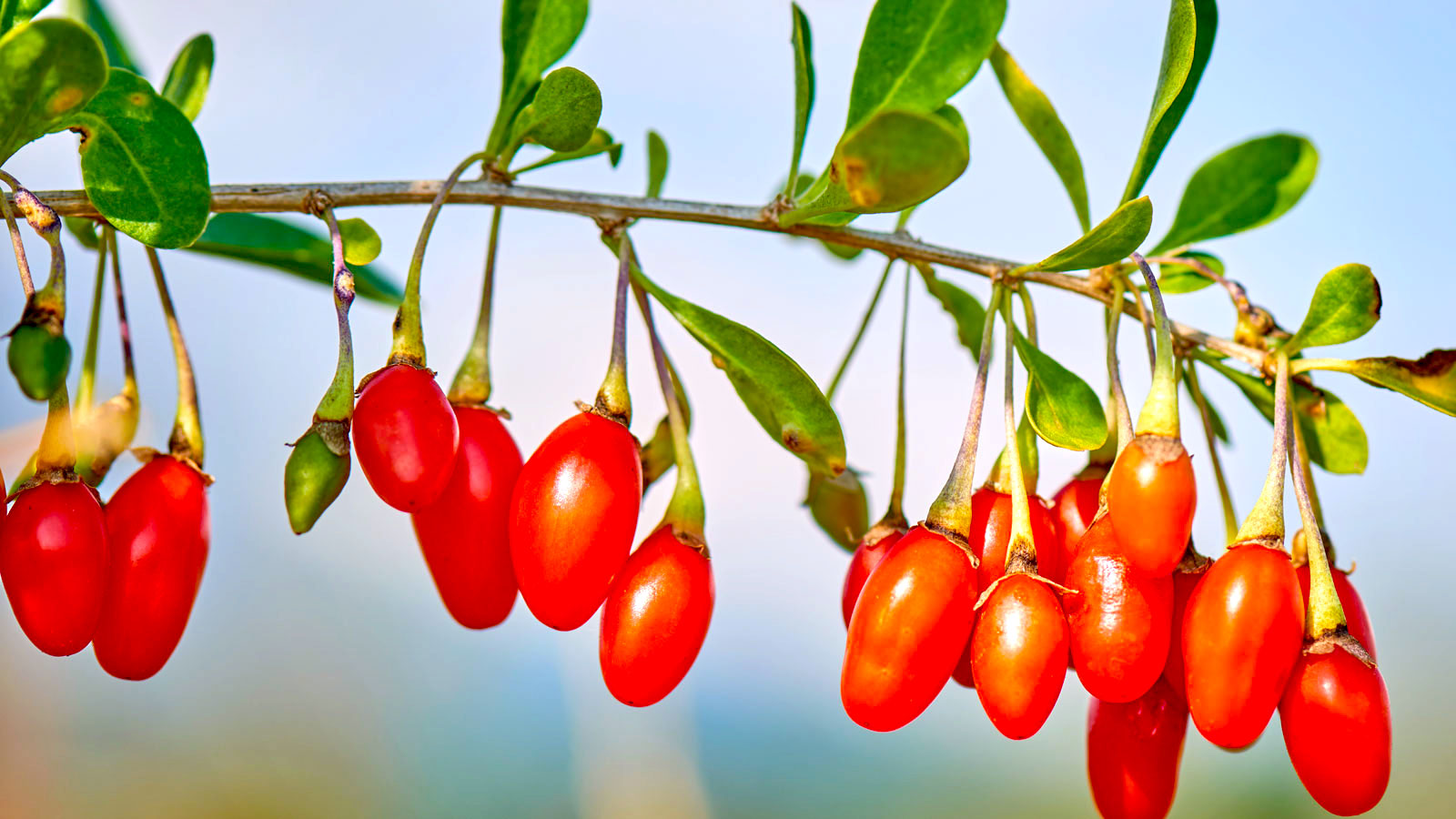

Finding out how to grow goji berries introduces you to one of the most nutrient–rich and easygoing superfruits around. This joyous plant (also known as the wolfberry) has its roots in Chinese medicine and has long been revered for its healing and anti-ageing properties. Alongside this impressive heritage, the goji shrub (Lycium barbarum) is finding new fans in the kitchen garden with its unique combination of hardiness, drought tolerance, low maintenance, strong resistance to pests and disease – and its generous cropping yields.
Ornamental and wildlife friendly, the goji berry shrub is a striking perennial, too. It produces dazzling violet blooms in late spring and early summer, before its long, flexible stems burst forth with an impressive fruit load. You can enjoy the berries fresh or dried, frozen or pressed as juices, and they get sweeter the longer you leave them on the stems. Rivalling the crops of the best fruit trees, these cheerful crops are a veritable powerhouse of vitamins, fibers, amino acids and antioxidants. Growing goji berries is a boon for the immune system, skin and eye health, acting as a powerful anti-inflammatory and a potent mood booster.
This, coupled with the goji’s ornamental splendor, means it is equally well suited to expansive plots and compact backyards. Happy flourishing in large containers, dedicated borders and raised beds, it is one of the most versatile cropping shrubs you can grow. Plus, these robust super-shrubs keep flowering and setting all summer, ensuring one of the happiest extended harvests in your kitchen garden. So, what are you waiting for? It’s time to make some room for gorgeous gojis.
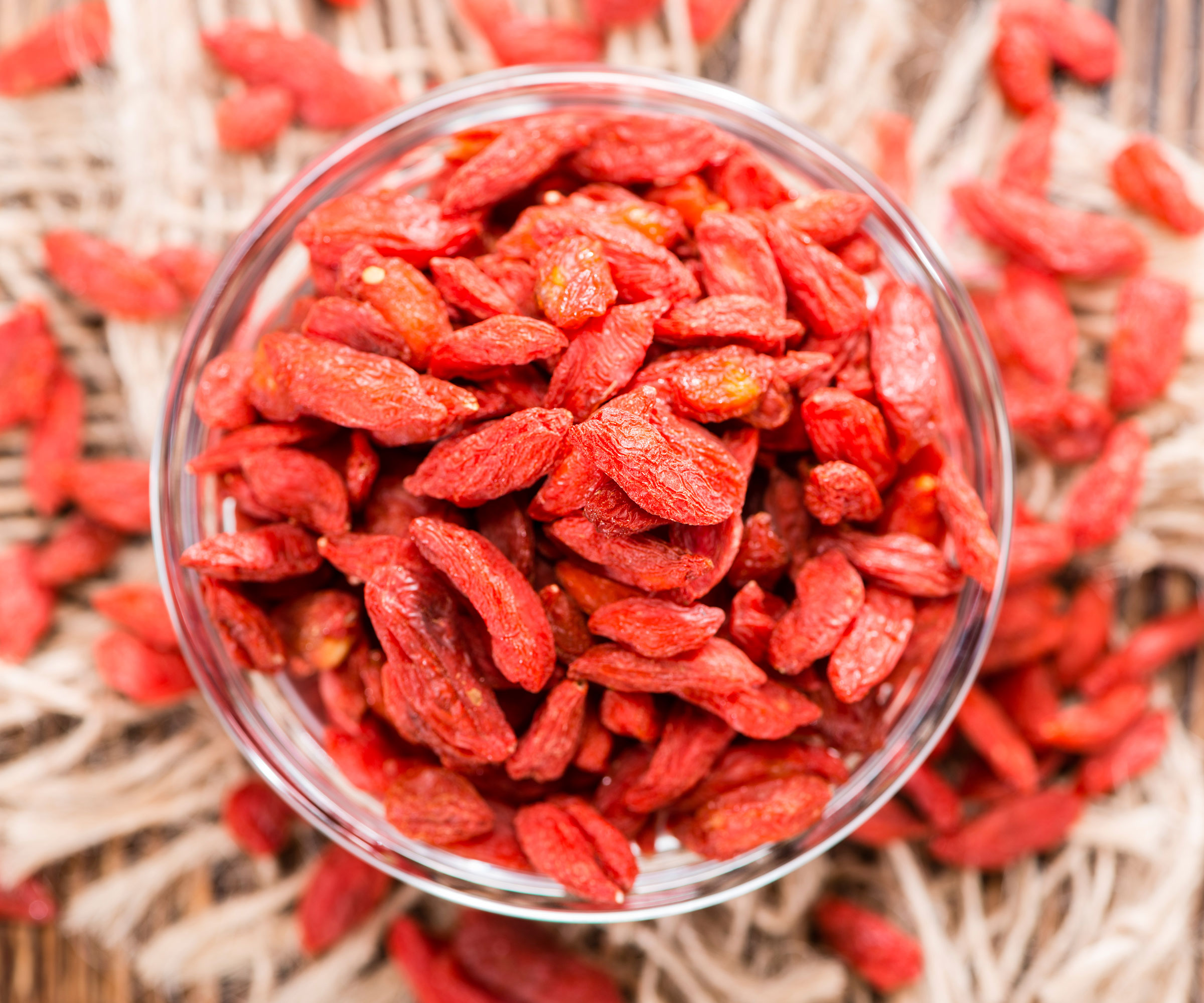
Once harvested, you can enjoy goji berries fresh or dried
Ideal conditions for growing goji berries
Knowing how to grow goji berries is made easier when you consider that they originated in the arid plains of East Asia. That affinity with dry, arid climates is key to identifying its ideal growing conditions.
As Fast Growing Trees' plant expert Tamara Hogan explains, gojis grow best with access to full sun – so the better the access to sunshine, the better your eventual harvest will be. ‘Fruiting plants are harvesters of light so don’t forget that when selecting your location,’ says Tamara. Any west or south facing garden spots will be ideal for growing goji berries, and preferably a position that catches at least eight hours of sun a day. ‘If you are in a warmer climate, afternoon shade can support plants during the summer heat,’ adds Tamara. ‘Afternoon shade alone may not help with fruit set, but it will help to minimize heat stress and leaf scorch.’
Experts describe gojis as being amongst the best low maintenance shrubs you can grow, as well as some of the most naturally drought tolerant. Because of that, it’s important to know which soil types you have in your backyard, so you can position your shrub accordingly. Alternatively, you can adjust the pH and condition of the earth prior to planting.
‘These plants prefer a pH level of 6.5-8,’ says Nina Roberts, plant manager at ShrubHub. If your ground leans towards the acidic, Derek Carter, founder and owner of Food Forest Nursery, suggests adding some lime to raise the pH level. Alternatively, as Tamara points out, you can grow your gojis in pots to better control the compost.
Also, make sure your soil is well-draining. If your soil is heavy, Nina suggests adding a little organic matter or planting in a raised bed. Derek reiterates the need for growing conditions that are on the slightly poor or infertile end of the spectrum. ‘These shrubs do best in sandy soils that can be of moderate or even low quality,’ he says. Goji berries grow well from pot-based or bare-root plants sourced from garden centers and mail-order suppliers like those here:
- Buy goji berry plants from Etsy
- Buy goji berry plants from Fast Growing Trees
- Buy goji berry plants from Food Forest Nursery
- Buy goji berry plants from Shrub Hub
- Buy goji berry plants from Walmart

Tamara graduated from Utah State University with a degree in Ornamental Horticulture and an emphasis in Greenhouse Management. She has worked within various horticulture fields. From floral design, she progressed to plant consults and teaching workshops at local nurseries. She took to commercial greenhouse growing and local lawn care, before joining Fast Growing Trees where she loves to talk about plants.

Derek discovered permaculture in his early twenties while working as a mechanical engineer. Thanks to its combination of design and sustainable food production, he became hooked. He received his Permaculture Design Certificate from Oregon State University, quit his job in Houston and started a homestead in Arkansas. He developed Food Forest Nursery from scratch, shipping out a few dozen orders, and now deals with thousands of customers annually. Next year, he plans to found a non-profit with the goal of installing food forests at every school in the US.
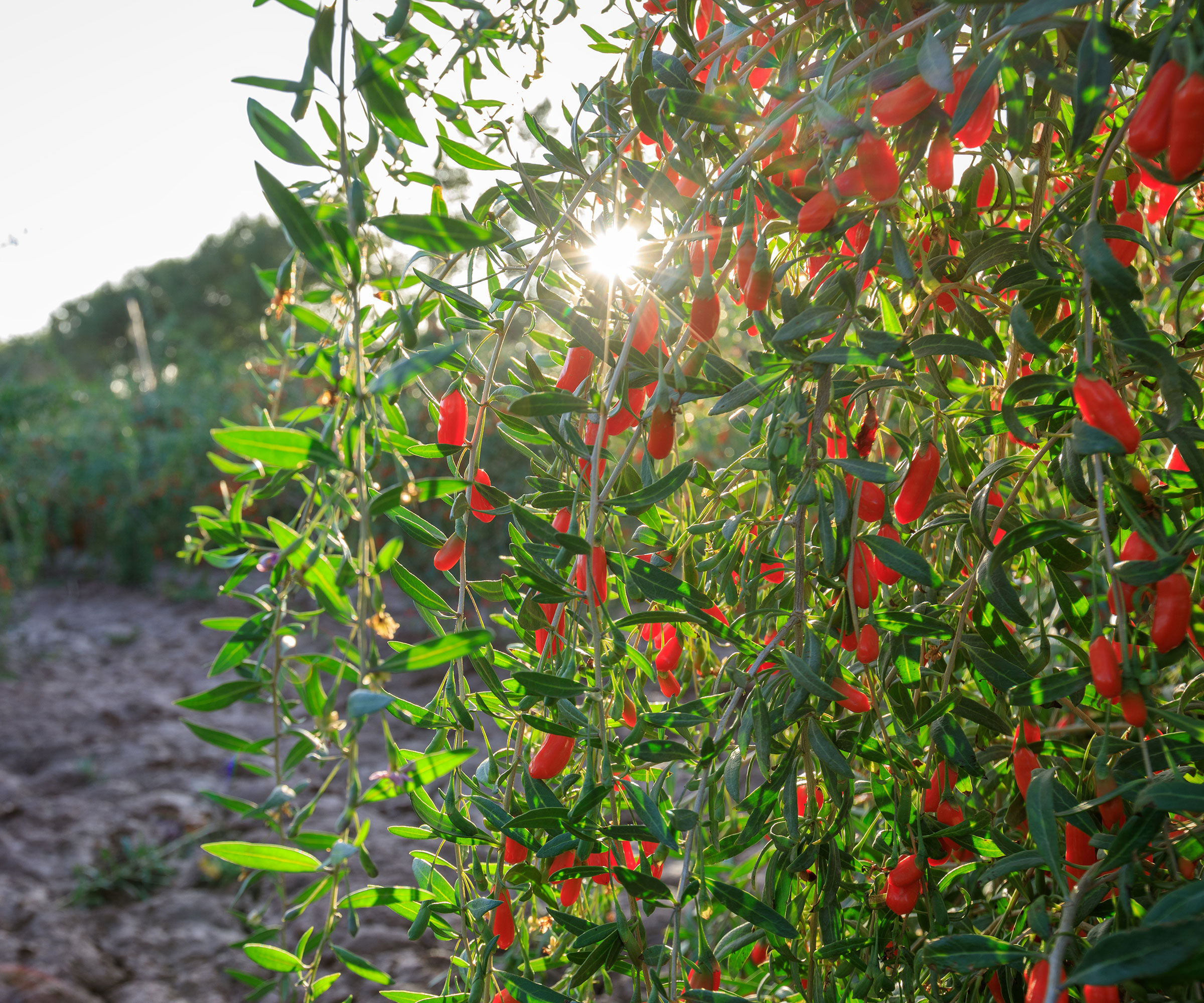
Goji shrubs grow best in full sun with a well draining soil
When and how to grow goji berries
The decision about when you plant and grow goji berries is determined by your hardiness zone. Gardeners have the best success with USDA hardiness zones 5-9. Just remember gojis crave long, hot and dry summers to give fruits maximum exposure to light and warmth. Allowing for regional variations, the ideal planting time is between late summer and fall.
If you do plant in the fall, give new shrubs a few weeks to settle in before the risk of big freezes – and protect plants from frost if a cold snap is due. If you are worried about your hardiness zone, a container-based option allows you to move plants indoors when needed. Growing in a pot also gives you more flexibility about when you plant your goji.
One of the best things about growing goji berries is that they are self-pollinating, so you only need one to get a fruit set. However, lovers of companion planting will appreciate that extra goji shrubs positioned nearby can increase the chances of a successful harvest. Figuring out how to grow gojis isn’t just a choice between borders, raised beds or containers, or growing alone or in combination.
It also involves deciding between a formal planting or something more naturalistic, as Homes & Gardens expert Lucy Chamberlain explains. Because of their sprawling habit (they can reach 6-8ft high), goji shrubs are perfect for forest gardening, says Lucy. This is an organic method which considers the benefits of ‘canopies’ and ‘zones’ of diverse cropping plants coexisting harmoniously, often in smaller spaces.
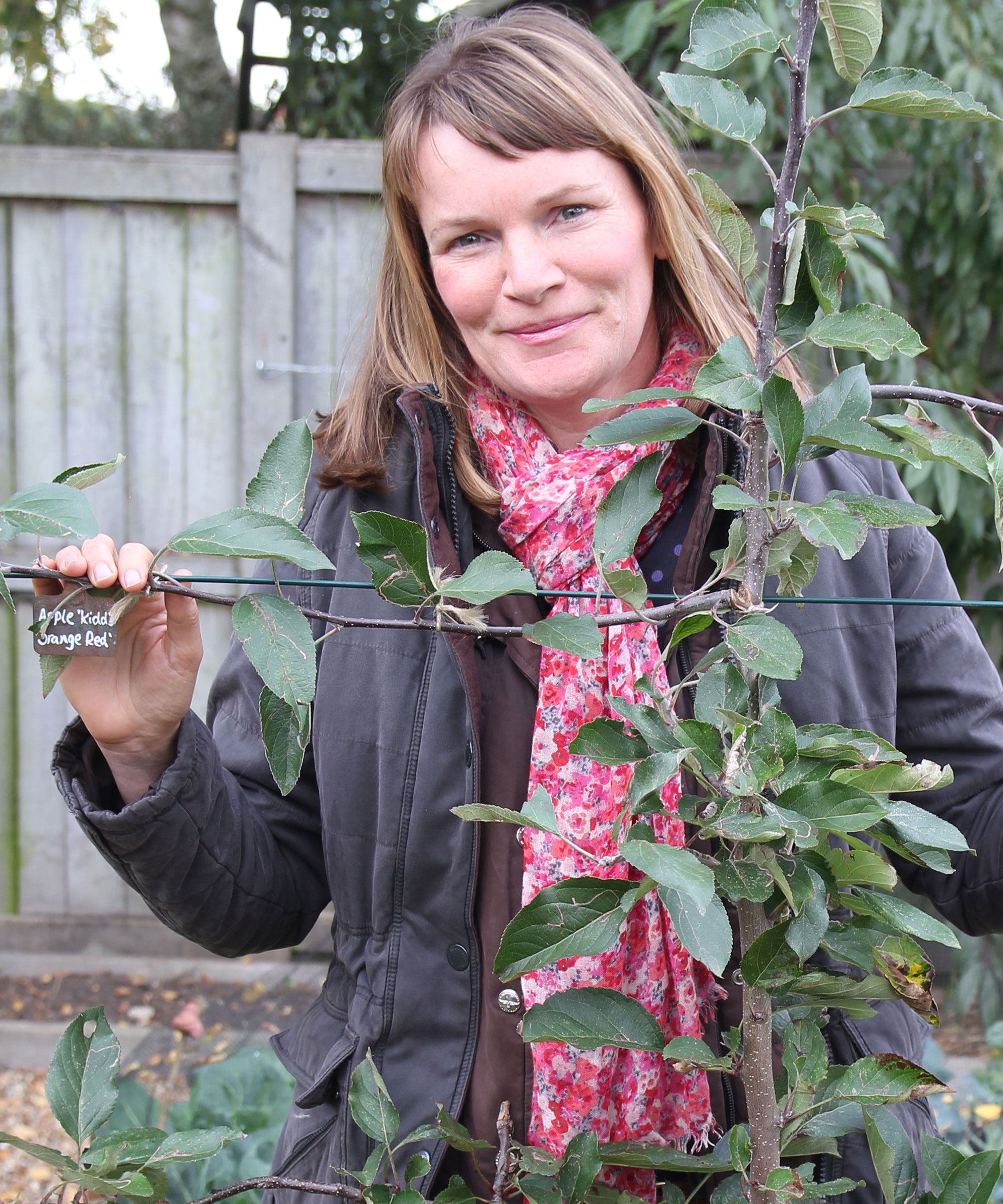
Lucy was a Horticultural Advisor at RHS Wisley and has been Head Gardener on a 100-acre estate in England for many years, but writes regularly for titles such as The Garden, Gardeners’ World, The Guardian and Amateur Gardening. She’s also the author of RHS Step by Step Veg Patch, which covers 50 types of fruit and veg. She enjoys growing dwarf pomegranates and cold-hardy breeds for more control over the seasons.
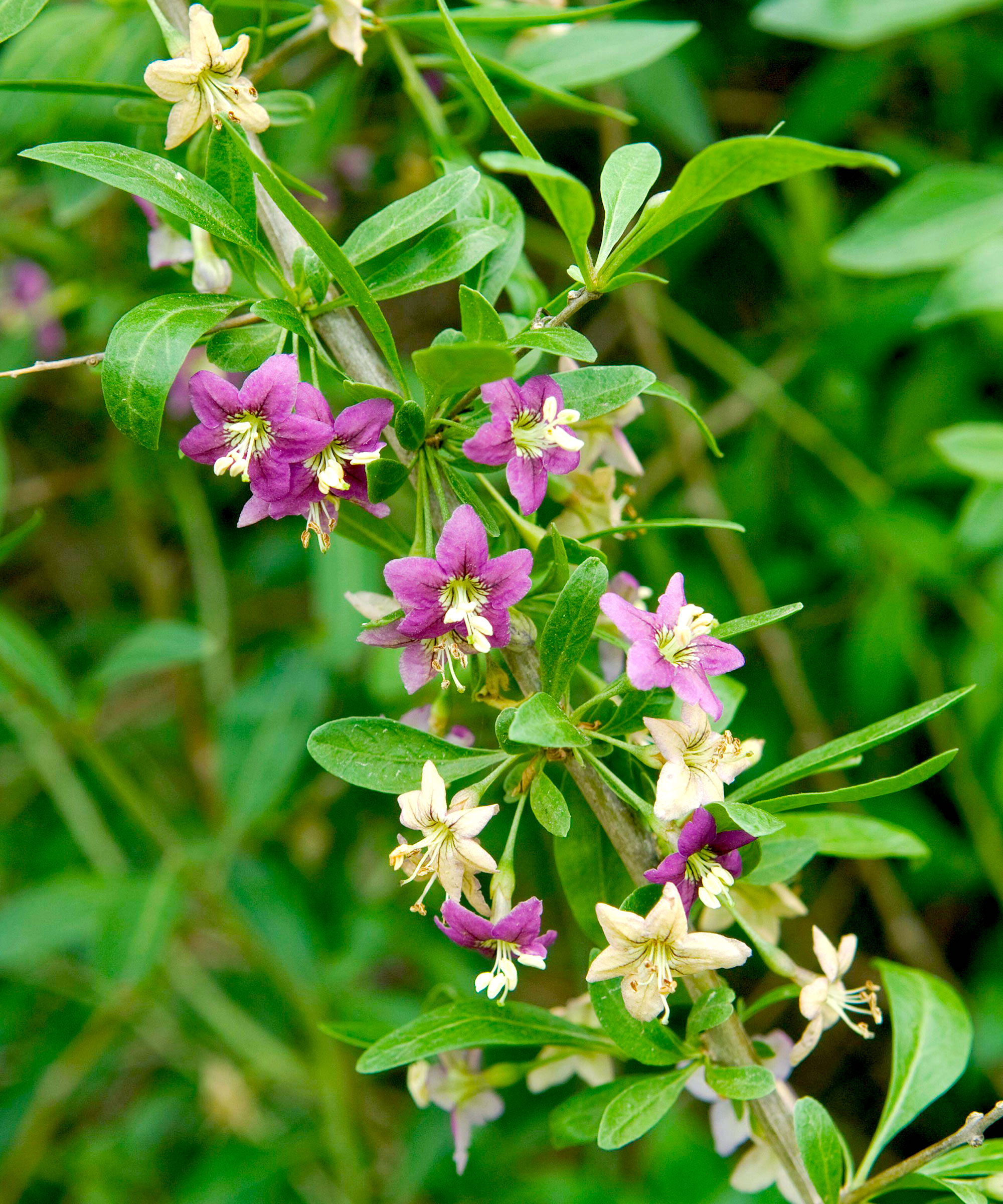
Though self pollinating, goji plants have a better chance of producing more fruit from flowers if you grow more than one
How to plant goji berries
Once you have ruled out the risk of frost, the main task before you start to grow goji berries is to prepare your soil. As we have pointed out, it doesn’t need to be perfect in terms of fertility. However, preparing garden soil will give young plants a good start. Condition the earth with some fish bone and blood, a little aged loam or well-rotted organic material.
Also check the structure of the earth is loose to allow for the healthiest root systems. Rake over a few weeks before planting if needs be. Once you’ve done this, knowing how to plant shrubs is a fairly straightforward process:
- Dig a hole in the earth that is around double the width of the root ball of the tree and about as deep. Add a little slow-release fertilizer to the base of the planting hole.
- Loosen the roots of the goji shrub. Place in the planting hole and fill with soil. If you’re planting multiple shrubs, space them 6-8ft apart.
- Water well, then monitor carefully for the first few weeks after planting. Make sure the earth doesn’t dry out completely.
- Give each planted goji a bit of time to settle into its new home. It takes a bit of time for their tap root to delve into the soil, so don’t worry if it takes a few weeks for new growth to develop.
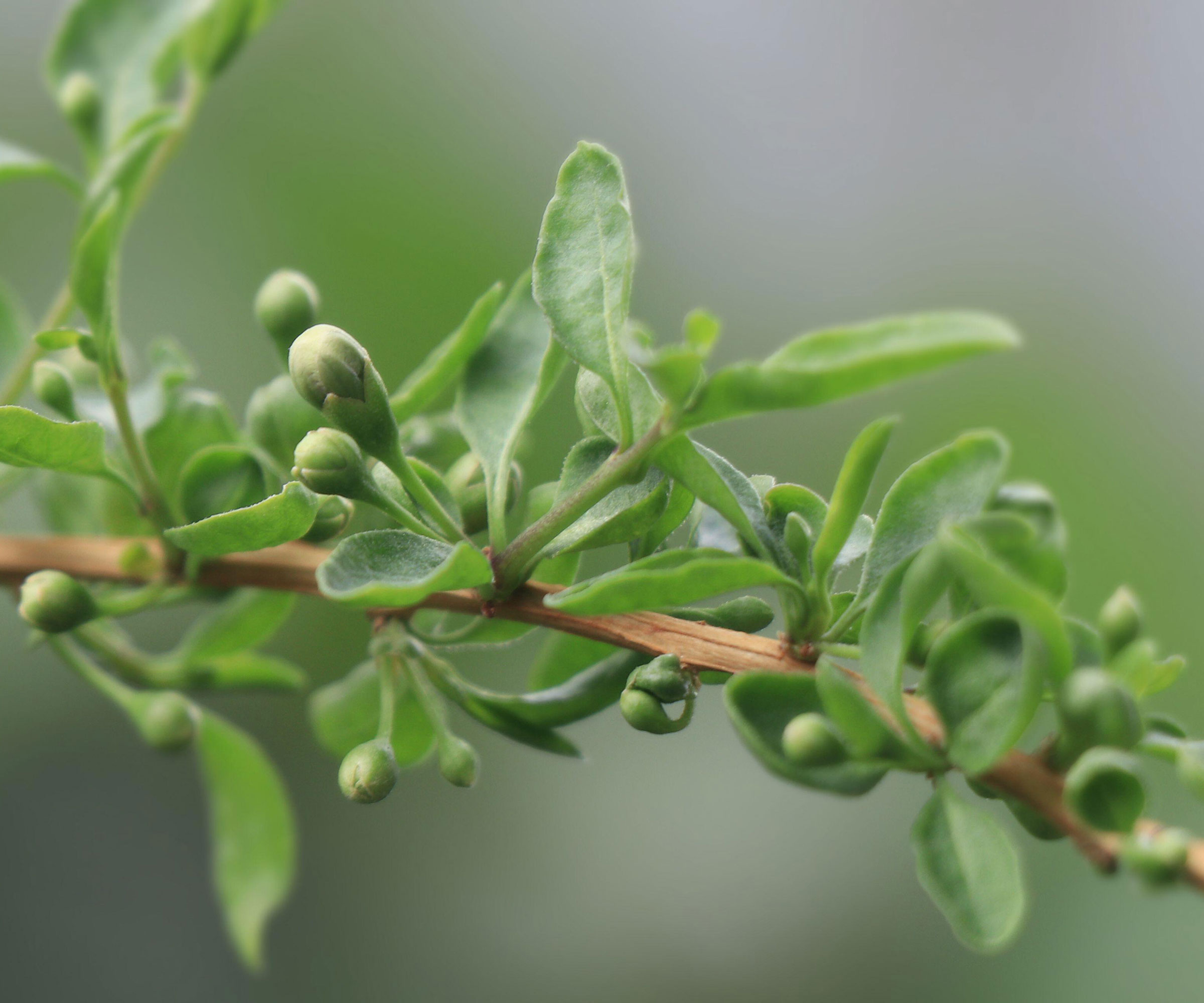
Planting in rich organic matter encourages earlier flowering and fruiting
How to grow goji berries in containers
Although you may prefer to know how to grow goji berries in the ground, there is an alternative. These fruiting plants are some of the best shrubs for containers, so as long as you select your tub carefully, the rest follows on neatly. Just bear in mind that growing goji berries as part of a container gardening grouping has a direct impact on its eventual size and spread. Growing these shrubs in pots forces more compact growth.
Whether you decide to go for a large tub, trough or planter, make sure it is a couple of pot sizes bigger than the one with which it came (assuming you bought a young shrub from a supplier). Check that it has adequate drainage holes, and boost drainage where necessary with the addition of pot feet. Use a decent potting soil or topsoil mixed with some sand, grit or perlite, and fill the container so a few inches is left clear at the top.
Watering is critical, both immediately after potting up and again as your goji shrub develops in the pot. One of the biggest container gardening mistakes is to misjudge moisture levels. Keep the compost moist but not waterlogged – and don’t let it dry out, either. Growing goji berries in containers means they are more prone to this, so check daily. Pot-based goji plants are also more prone to losing nutrients, so add a balanced liquid-based feed once a month during the growing season. Once you see new growth, it’s a good sign that the shrub is taking to its new home.
Finally, give potted gojis plenty of sunshine and warmth, whether that’s outdoors in summer or in a well-lit sunroom, greenhouse or sunny windowsill over winter.

Choose large tubs with adequate drainage if you want to grow goji berries in containers
Goji berry care tips
Once planted, cultivation is straightforward. The knack to knowing how to grow goji berries with optimum sweetness and nutritional load is to monitor sunshine, warmth and hydration. Watering is a critical activity. However, as Derek Carter points out, knowing when to water plants is more of a factor as you wait for shrubs to establish. Even then, it’s not something you do indiscriminately.
‘They need sufficient water in the first year, but make sure they don’t get waterlogged,’ says Derek. As Nina Roberts points out, that can lead to root rot. Water well in dry periods, but less when soil is retaining moisture. Tamara Hogan recommends watering the base to reduce the risk of fungal diseases. ‘Deep watering provides for better root establishment,’ she adds. Once goji berry plants mature, they are some of the best drought tolerant shrubs you’ll grow.
Another vital task to help promote the vitality of gojis is a well-timed feed. ‘Goji berry plants do not require heavy feeding,’ says Nina. ‘Still, a balanced organic feed in early spring can provide a nutrient boost.’ A word of caution about quantities, however: ‘Gojis will signal for vegetative growth over flowering/fruiting growth if over-fed,’ warns Tamara. ‘Anything above a 15-15-15 blend will over-fertilize plants and cause them to shoot out more leaves and stems versus flowers.’ Another slow-release feed can be applied in the fall, depending on soil conditions. It’s also wise to add a good mulching early in spring, and again in the fall, to help regulate moisture levels and protect from weather extremes at either end of the year. ‘Use straw, wood chips, or compost and ensure the mulch is not piled against the plant's stem,’ says Nina.
If you want to grow goji berries that are sufficiently balanced as they develop, consider support and training. ‘As goji berry plants grow, they may develop long, flexible branches,’ says Nina. ‘Use stakes or trellises to help them grow upright and prevent branches from touching the ground.’
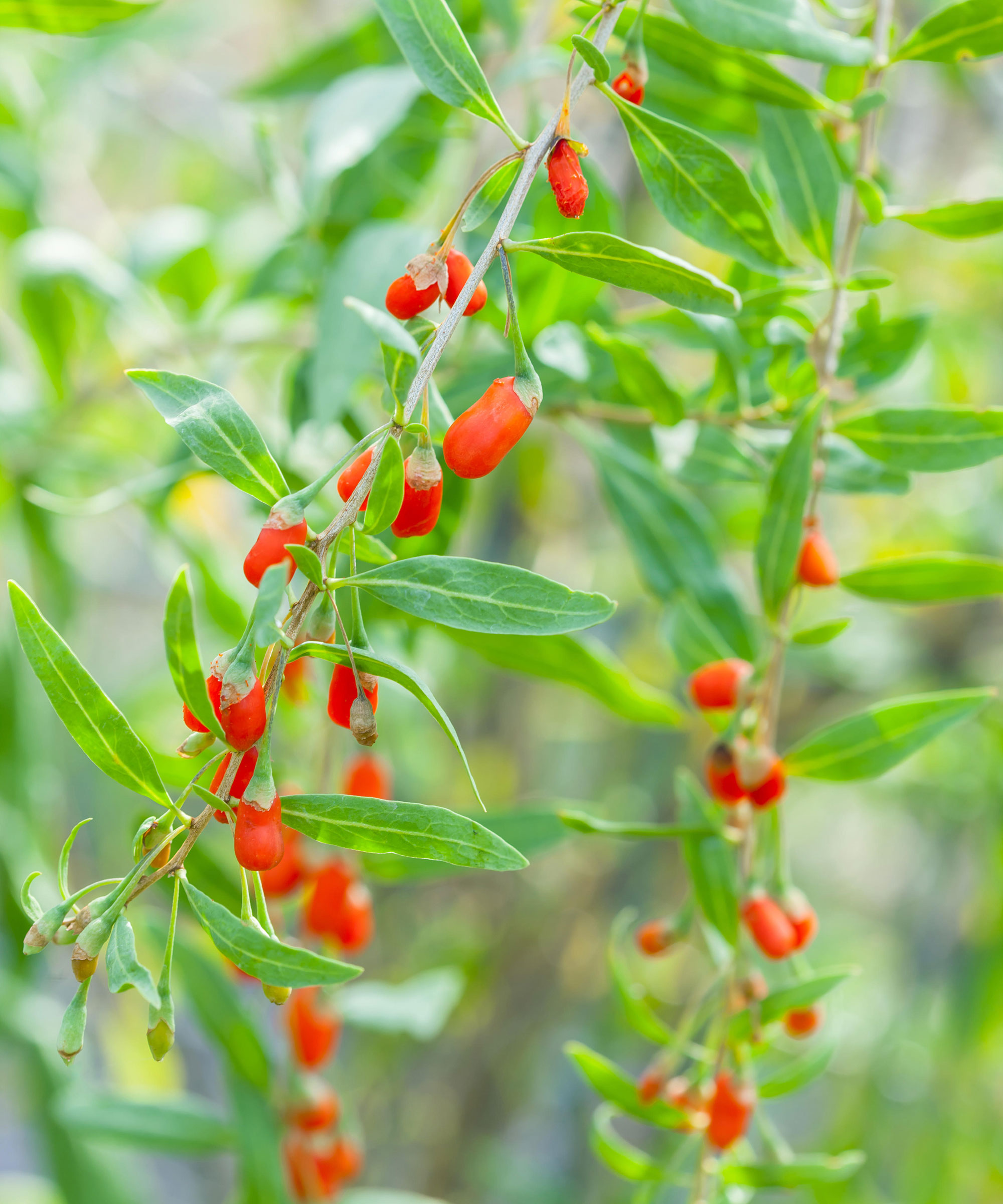
Regular watering will help ensure that ripening berries are healthy and juicy
Problems growing goji berries and how to tackle them
Learning how to grow goji berries, you needn’t worry about a lot of the problems that befall other types of fruiting plants. However, there is still a risk your shrub may be exposed to fungal issues or diseases like powdery mildew, says Tamara Hogan.
‘These are caused by poor air circulation and humidity fluctuations,’ she says. Maintaining good airflow is the best prevention. If you want to get rid of powdery mildew, try an organic fungicide or homemade spray made of neem oil or diluted vinegar, applied at regular intervals. Also, keep a close watch on soil health, ensure the ground is well draining and allow plenty of time between watering.
You also need to keep an eye out for common issues like aphids or mites, says Nina Roberts. Goji gall mite is a particular foe of this type of fruiting shrub. They can overwinter in the bark and tend to affect leaves. ‘If detected, treat with appropriate organic pest control methods or consult a local gardening expert for advice,’ she adds. You can also get rid of aphids by encouraging ladybugs and lacewings. Grow plants like dill, cosmos, daisies and fennel nearby, which are conducive to their presence. You can also target aphids with short bursts of water on leaves or by spraying with mild soap or horticultural oil.
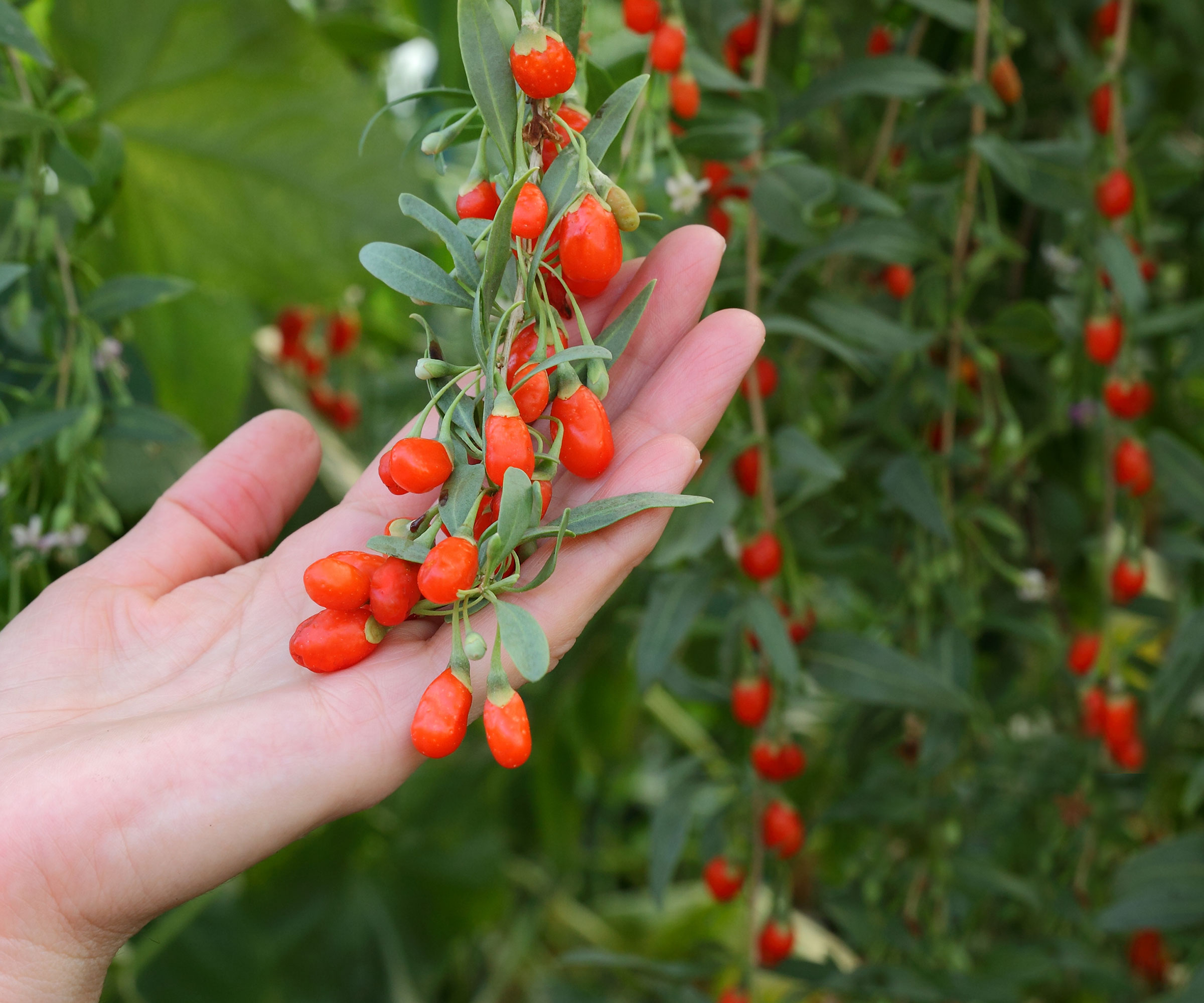
Checking that ripening crops receive good airflow helps to prevent powdery mildew
FAQs
Can you grow goji berries from seeds?
Growing productive fruiting shrubs from seed isn’t a quick process. You’ll need to allow at least three years (and possibly as many as five) for young plants to establish. But if you want to know how to grow goji berries by collecting seeds and planting them, it is possible. Start seedlings under glass or sow direct in spring, ensuring that the young plants receive six-eight hours of direct light each day.
If sowing direct, use cloches or cold frames to protect emerging seedlings from extremes of weather. Indoors, you might find it helps to start them off in a propagator to regulate warmth. As plants develop, you can move them on to larger pots if growing indoors. Once you are ready to move your goji plants outside, harden off for a week-10 days. Choose a dry day for planting out, and make sure the soil is warm, rich and watered well.
Can you grow goji berries from cuttings?
For anyone wishing to know how to grow goji berries from plant cuttings, you’re in luck. You start off hardwood cuttings in late winter (or softwood cuttings in early spring, making sure to keep them covered). More importantly, take cuttings and transplant seedlings from a goji shrub that you know has fruited. Experts believe this will give you a head-start over any tree you attempt to grow from seed.
Make cuts where the wood is half an inch thick, and ensure cuttings are 8in long. Cut the base at an angle, and dip in rooting hormone. Plant in moist, well-draining compost underglass. Keep emerging seedlings and young plants under glass for the duration of winter. You should see new shoots the following spring, at which point you can plant out after hardening off.
As you can see, with a little bit of care and attention, and the right growing conditions, you could be enjoying bumper harvests of these nutrient-packed goji berries. If you're keen on knowing how to cultivate even more superfoods, why not have a look our guides on how to grow quinoa, how to grow soybeans, how to grow kale and how to harvest chia seeds. Growing nutritious homegrown crops just got even easier.
Sign up to the Homes & Gardens newsletter
Design expertise in your inbox – from inspiring decorating ideas and beautiful celebrity homes to practical gardening advice and shopping round-ups.

As assistant editor of Amateur Gardening magazine, Janey's gardening passion was fostered from an early age, when her amazing mum had her deadheading hydrangeas, mulching roses, and propagating strawberry plants from runners for school open days. She's also taken part in lots of conservation and rewilding projects for the RHS and TCV as a way of exploring her horticultural horizons.
-
 This once-dated kitchen is now a timeless space with the coziest details – and its the classic color palette that's made it a chic, welcoming space
This once-dated kitchen is now a timeless space with the coziest details – and its the classic color palette that's made it a chic, welcoming spaceWarming colors and natural materials combine to create this enduringly classic kitchen scheme
By Molly Malsom Published
-
 How to grow crepe myrtle in pots – and transform even the smallest of yards with dazzling flowers this summer
How to grow crepe myrtle in pots – and transform even the smallest of yards with dazzling flowers this summerGrowing crepe myrtles in pots will inject splashes of brilliant color into your outside space
By Thomas Rutter Published